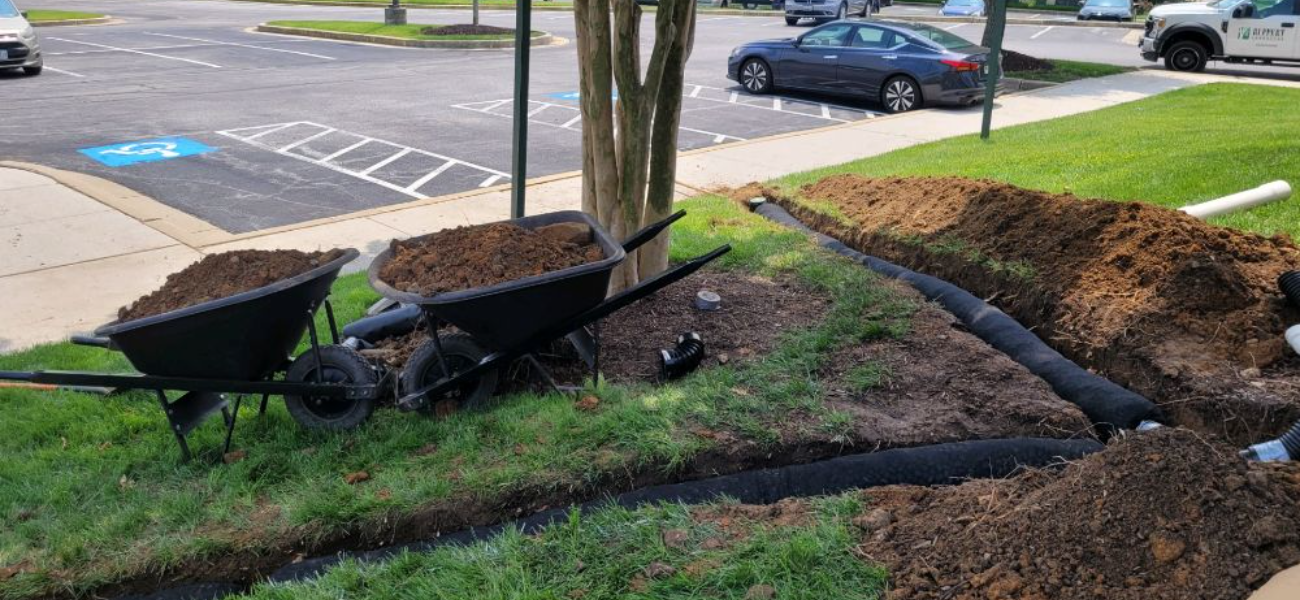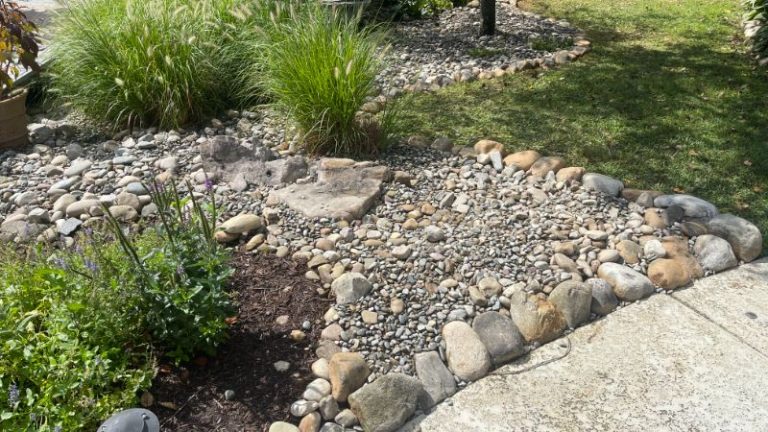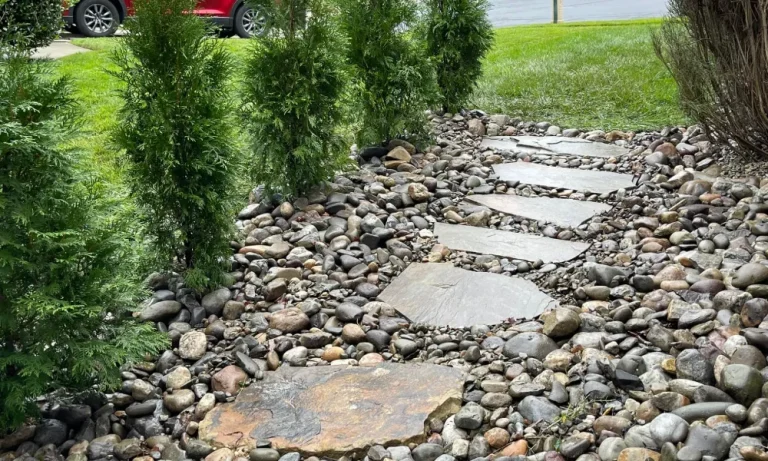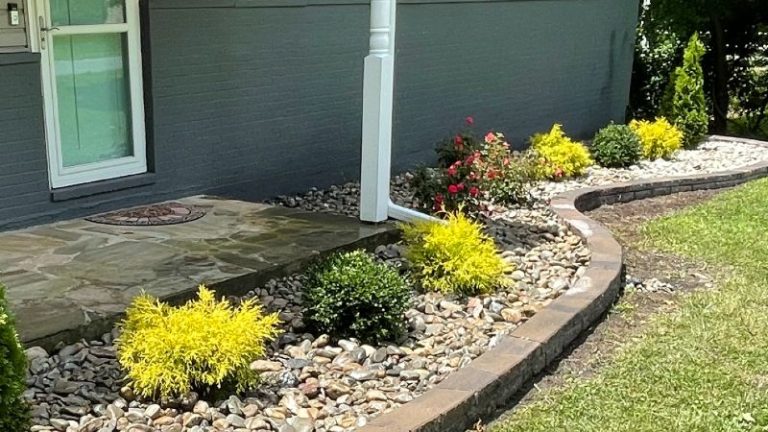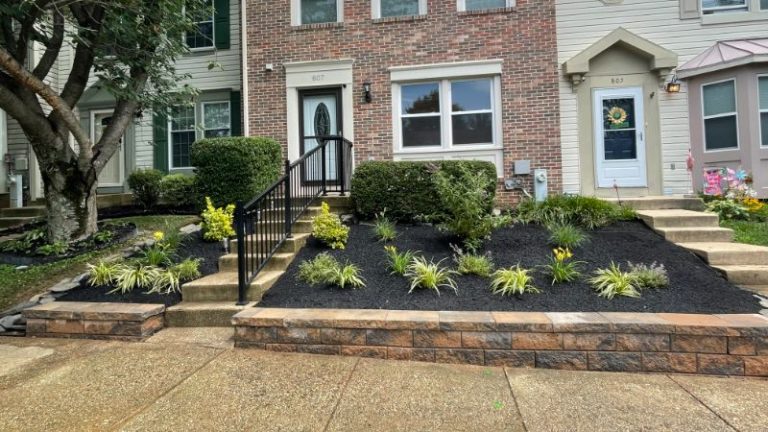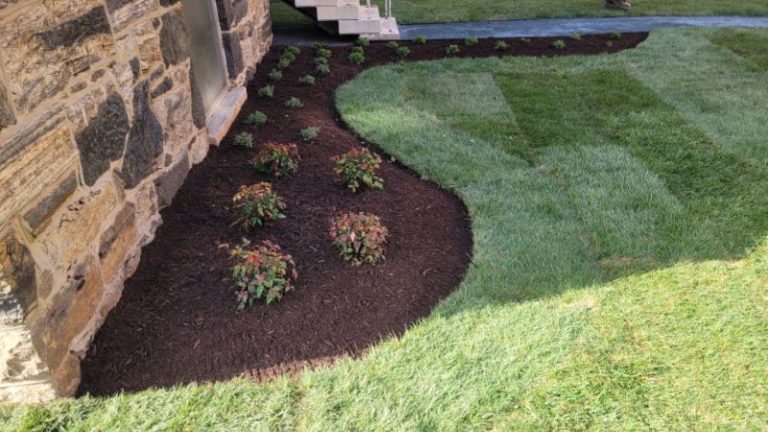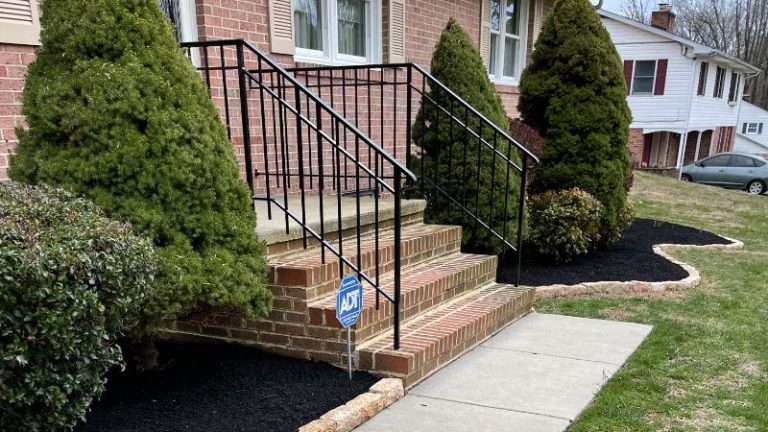What Is a Drainage Swale and Where Should It Be Used in My Landscape?
Understanding Drainage in Landscaping
Drainage is one of the most critical—and often overlooked—aspects of a healthy landscape. Without proper drainage, water can pool around your foundation, flood planting beds, erode soil, or damage hardscaping features. One effective way to manage stormwater runoff and control erosion is by using a drainage swale.
If you’re a homeowner in Harford County or the surrounding areas struggling with standing water or soggy areas in your yard, learning how drainage scales work can help you make informed decisions and protect your outdoor investment.
What Is a Drainage Swale?
A drainage swale is a shallow, gently sloped channel built into the landscape to redirect surface water runoff away from structures, patios, and low-lying areas. Unlike traditional underground drainage pipes, a swale functions on the surface and uses the natural grade of the land to guide water toward a designated drainage area, such as a rain garden, dry creek bed, or stormwater outlet.
For homeowners in Harford County and the surrounding Maryland areas, drainage swales are a smart, eco-friendly way to manage water on properties with poor drainage, heavy clay soils, or sloped yards. When designed and installed properly, they not only protect your home and landscape from water damage—they can also become attractive design features when enhanced with stone, mulch, and erosion-resistant plantings.
Why Drainage Swales Matter in Maryland Landscapes
In areas like Bel Air, Abingdon, Forest Hill, and Fallston, seasonal rains can quickly overwhelm compacted soils and cause water to pool near foundations, hardscape features, or in garden beds. Left unaddressed, this excess moisture can lead to:
-
- Foundation and basement issues
- Erosion around retaining walls and patios
- Damage to plant roots or turfgrass
- Unsafe, soggy areas in lawns or walkways
A drainage swale solves these issues by working with the natural slope of your property—not against it.
Key Features of a Well-Designed Swale:
-
- Shallow, contoured trench that moves water without creating safety hazards
- Slight grade (usually 2–4%) to ensure consistent water flow away from the home
- Optional lining with grass, river rock, or mulch to improve appearance and slow down water velocity
- Integration with other landscape elements, such as garden beds, dry creek beds, or retaining walls
- Planting with native, deep-rooted vegetation to prevent erosion and support pollinators
Complementary Services That Improve Drainage Swales
At Harvest Outdoor Living, we specialize in building custom swales as part of a comprehensive landscape drainage strategy. Our team often combines swales with:
-
- Grading and soil contouring to correct uneven terrain and promote natural runoff
- Dry creek bed installation for enhanced water absorption and visual appeal
- Retaining walls to manage elevation changes and redirect runoff on sloped properties
- Paver patios and walkways with built-in drainage channels
- Mulch and planting services to stabilize the swale and tie it into the overall design
- Landscape lighting to illuminate low-lying areas and improve nighttime visibility
Whether your home is dealing with standing water in the backyard, erosion near a slope, or poor drainage around a patio, we can design a custom solution that blends function with beauty.
Where Should a Drainage Swale Be Used?
A drainage swale isn’t a one-size-fits-all solution—but in the right setting, it can solve some of the most persistent water issues in your landscape. Swales are particularly useful for properties in Harford County and nearby Maryland communities, where seasonal rainfall, dense soils, and hilly terrain can lead to water pooling in unwanted places.
Here are the most common and effective areas to install a drainage swale:
1. At the Base of Slopes or Hillsides
If your yard slopes toward your home, garage, or outbuildings, a drainage swale is essential for protecting your foundation. These swales intercept rainwater before it reaches the base of your structures, guiding it safely downhill to a designated drainage point—often a dry creek bed, rain garden, or natural runoff area.
In Maryland’s clay-heavy soils, which retain water, this is especially important for preventing basement seepage, foundation cracking, or saturated mulch beds near your house.
2. Along Property Lines
Swales are frequently installed along property edges to manage water that flows in from neighboring yards, sloped driveways, or roads. These border swales prevent disputes by keeping excess runoff contained within your landscape and reducing the risk of flooding adjacent properties.
They also create a natural barrier that can be dressed up with decorative stone, native plantings, or mulch, tying into a more extensive landscape bed or privacy hedge installation.
3. Between Raised Beds, Patios, or Hardscape Features
When hardscaping elements like paver patios, retaining walls, or outdoor kitchens are added, they often alter the natural flow of water across your yard. Without proper planning, water can collect in low spots or create runoff patterns that erode soil or flood your outdoor living space.
A swale can be designed to fit between or alongside hardscape elements, collecting and guiding water away before it becomes a problem. Our team at Harvest Outdoor Living frequently includes swales as part of larger drainage and hardscaping projects, ensuring the entire space works as one cohesive system.
4. Low Spots or Areas with Standing Water
Do you consistently have soggy areas in your yard that take days to dry after rain? These waterlogged patches are not only unsightly—they’re also bad for turf health and create breeding grounds for mosquitoes.
A properly graded swale gives that water a place to go, allowing it to drain or soak into the ground more efficiently. In some cases, we enhance these areas with dry creek beds, decorative gravel, or drought-tolerant plants to absorb moisture and create an attractive, low-maintenance landscape feature.
By evaluating the unique drainage patterns of your property, Harvest Outdoor Living can design a swale system that not only fixes existing water issues but also complements your landscape’s style and layout.
Benefits of a Properly Installed Drainage Swale
When designed and built correctly, a drainage swale is one of the most practical, cost-effective, and environmentally friendly solutions for residential water management. At Harvest Outdoor Living, we don’t just dig trenches—we integrate swales seamlessly into your landscape to protect your property, preserve plant health, and enhance the beauty of your outdoor space.
Here’s a closer look at the key benefits of a professionally installed drainage swale:
Reduces Flood Risk
Heavy rainfall is common in Maryland, and without proper drainage, stormwater can quickly collect near your home’s foundation, basement windows, sidewalks, or driveway. A swale redirects this water away from critical areas, reducing the risk of flooding in and around your home. This is especially important for homes built on or near slopes or those with poorly draining clay soils common in Harford County.
Protects Landscaping and Gardens
Too much water can be just as harmful as too little. Persistent puddling or saturation in your garden beds can lead to root rot, plant disease, or even the death of valuable shrubs and trees. A swale helps control the amount and direction of water flow, ensuring your garden beds, mulch areas, and new plantings stay healthy. It also helps prevent mulch or soil from washing away after heavy storms.
As part of our landscape installation services, we often design planting beds that work in tandem with swales to enhance both beauty and function.
Controls Erosion
When rainwater flows unchecked down a slope or across bare soil, it can quickly strip away topsoil, damage turf, and undercut patios or walkways. A drainage swale is designed to slow down and redirect water, minimizing its erosive force. We often incorporate retaining walls, stone edging, or ground cover plantings into the design to further protect your landscape from erosion, especially in hilly or uneven areas.
Eco-Friendly and Sustainable
Unlike concrete drainage systems that simply push water away, a swale encourages natural infiltration—giving rainwater time to soak into the ground and recharge local groundwater tables. This reduces runoff into storm drains and waterways, making it a more environmentally responsible choice. For even more impact, swales can be connected to rain gardens or dry creek beds that further promote water conservation and reduce pressure on municipal drainage systems.
Visually Appealing When Properly Designed
A swale doesn’t have to look like a ditch. When planned by a skilled landscape designer, it can become a beautiful, integrated part of your yard. At Harvest Outdoor Living, we enhance swales with:
-
- Decorative river rock or gravel to mimic a dry creek bed
- Ornamental grasses and native perennials to soften the look and prevent erosion
- Boulder accents and mulch to tie the swale into nearby patios or garden beds
- Landscape lighting to improve safety and highlight natural contours at night
The result is a functional drainage solution that adds texture, interest, and curb appeal to your property.
Why Professional Drainage Solutions Matter
While a drainage swale might seem simple, poor design or placement can make problems worse. At Harvest Outdoor Living, we evaluate your property's topography, soil conditions, and existing landscape features to design drainage solutions that are both effective and attractive.
Our team specializes in:
-
- Custom drainage swales and grading
- French drains and underground piping
- Downspout extensions
- Retaining walls with integrated drainage
- Full landscape design and planting services
- Paver patios, walkways, and hardscape installations
We ensure your drainage system works seamlessly with your landscaping, protecting your investment for years to come.
Local Expertise You Can Count On
- Bel Air
- Abingdon
- Aberdeen
- Churchville
- Fallston
- Forest Hill
- Havre de Grace
- Jarrettsville
- Perry Hall
- White Marsh
- Other surrounding towns in Harford County and nearby areas in Maryland
Take Control of Water in Your Landscape
Don’t let poor drainage ruin your yard or damage your property. Contact Harvest Outdoor Living today to request a free consultation or estimate. We’ll evaluate your landscape, explain your options, and design a system that keeps your yard beautiful, functional, and dry.
Whether you're in Bel Air or beyond, our landscaping and hardscaping experts are ready to help with drainage swales, grading, and complete outdoor living solutions tailored to your needs.

